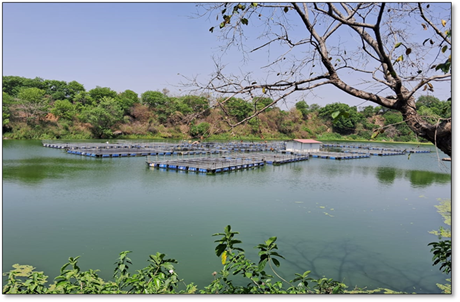CCL pisciculture projects are designed to address multiple challenge
Central Coalfields Limited (CCL) has transformed a number abandoned mine pits into thriving fish farms, promoting responsible use of natural resources and boosting local economy and biodiversity. CCL, a subsidiary of Coal India Limited, is making remarkable progress in sustainable development by spearheading innovative pisciculture initiatives under the guidance of the Ministry of Coal.
CCL’s pisciculture projects are designed to address multiple challenges—economic and environmental. The initiative primarily benefits the local communities by offering an additional source of income and also contributes to the state’s fish production.
CCL has developed five abandoned mine pits for pisciculture, with impressive results in both community engagement and fish production:
- Religara Pisciculture Project, located in the Argada Area of Hazaribagh, Jharkhand, spans across 9.71 Ha. A total of 20 fish cages have been installed, with an annual production of approximately 9.6 tonnes of fish. This project directly benefits around 100 residents from the nearby villages of Religara and Baskudra. It is also supported by the district administration.
Religara Pisciculture project
- Gidi A Pisciculture Project, situated in the Argada Area in Jharkhand, covers an expansive 28 Ha. With the installation of 22 fish cages, the project yields an annual production of approximately 0.72 tonnes of fish in initial year. It benefits the residents of Tehratand, Kendiyatola, and Gidi Basti. The project is poised for further development, including beautification efforts involving support of ₹45 lakhs. Additionally, it is proposed for designation as a Ramsar site, underscoring its ecological importance.
Gidi A Pisciculture project
- Bokaro OCP Pisciculture Project in Jharkhand spans 4.22 Ha, with 27 fish cages installed. This project produces an impressive 81 tonnes of fish annually, benefiting 30 local families. The fish species farmed include Pangasius, Rohu, Tilapia, and Katla, contributing to the local fish production and supporting the livelihoods of the surrounding community.
- Central Saunda Pisciculture Project in the Barkasayal Area in Jharkhand features 40 fish cages for Tilapia species, installed in November 2023. The project is expected to generate a significant output, directly benefiting around 250 local villagers, providing them with sustainable income opportunities and boosting the local economy.
- Karkatta A & Karkatta C Pisciculture Projects in the NK Area are key contributors to regional aquaculture. Karkatta A covers 1.80 Ha, with 15 fish cages, producing 200 tonnes of fish annually while Karkatta C, the larger of the two, spans 4.5 Ha, housing 50 fish cages and will yield an impressive 800 tonnes of fish annually. Together, these projects will benefit local villagers, providing significant production outputs that play a crucial role in supporting regional development and community welfare.
Karkatta A & Karkatta C Pisciculture project
CCL’s pisciculture projects have been a game-changer in revitalizing water filled mine pits, transforming them into sources of livelihood for local communities. These projects contribute to the overall economic upliftment of rural areas while promoting ecologically responsible water filled abandoned mine pits. With several projects slated for completion by 2025, CCL is setting an exemplary model for sustainable industrial practices in the coal sector.
The progress of these pisciculture projects represents a significant leap towards addressing both the socio-economic and environmental needs of the region. Through this initiative, CCL is championing a balanced approach where community welfare and biodiversity conservation go hand in hand.
